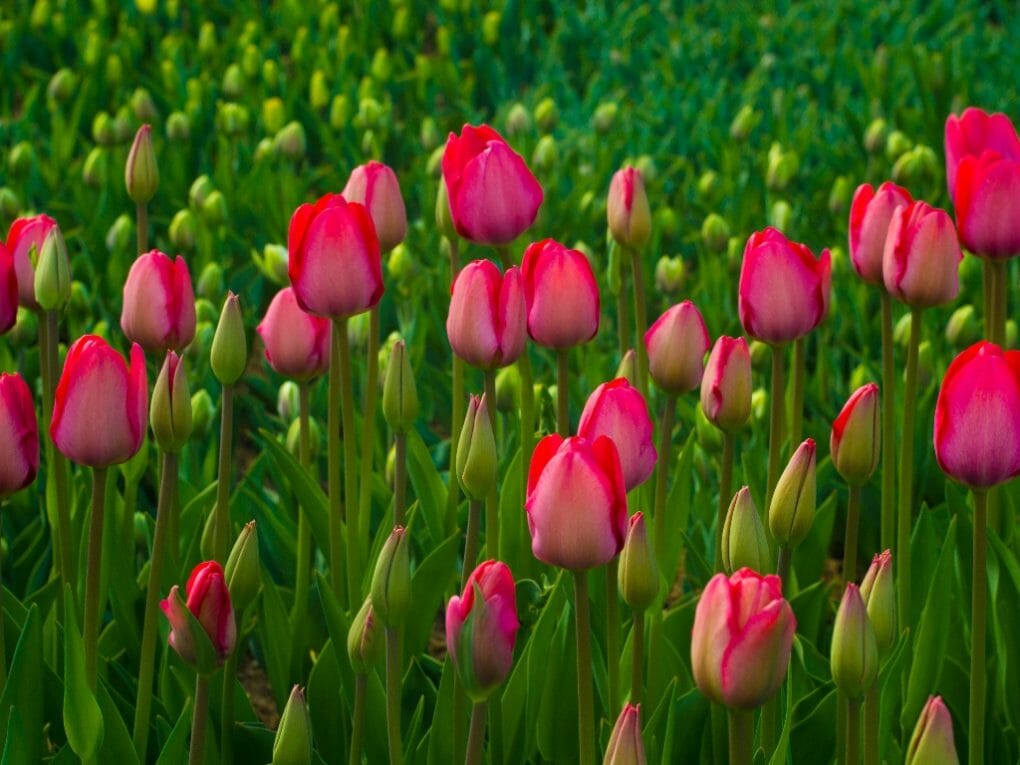Do Tulips Need a Lot of Water? Tulip Water Requirements

Tulips don’t require a lot of water, but they will appreciate it if you give them enough. Otherwise, regular watering will be sufficient. Every week, you should water your tulips. Tulips need 17mm, or 2/3 of an inch, of water per week, especially in late winter and early spring, when the plant is about to start producing flowers. Unless there is a drought, tulips need very little extra watering. If you live in a snowy state, you probably won’t need to water your plants, but you must ensure they drain well so they don’t rot. Watch the soil and make sure your tulips have enough water. Most of the time, tulips only need rain to grow and do well. If it rains for a few weeks, you might not need water.
Table of Contents
Tulip Water Requirements
In any given week, as long as there is at least one rainstorm sufficiently soaking, you shouldn’t have to do supplemental watering for your tulips. However, if you reside in an area that receives little rain naturally, you should continue to water your plants once a week. Because the dirt in pots dries up faster than in the ground, you may need to water your tulips more frequently if you grow them in pots. When tulips are overwatered, the soil becomes waterlogged, and the roots cannot absorb nutrients and oxygen. Tulips can become saggy when overwatered. The guidelines are a little different if you grow your tulips in containers. However, it is important to remember this because tulips grow best in dry soil. You don’t need to maintain the soil wet just because you put tulip bulbs in containers. They will take care of themselves.
Water After Planting
After planting, tulips, like many other flowering plants, must keep their soil moist with water. To kickstart their development, bulbs of any kind need water, but tulips require a particularly careful balance of the two. They can’t develop without water, yet tulips don’t like having their feet wet as much as we do.
Watering Procedure
The amount of water that tulips require is relatively low. All that is required is a watering pail to accomplish the task. Instead of using a garden hose, be careful not to touch the stems of the tulips with a strong spray of water, and do your best to work quickly.
Using Pail

- The most effective instrument for watering tulips is a pail or similar container.
- Put soil inside a container that has a circumference of six inches. Place the bulbs so their pointed ends are one inch below the pot rim. Place the bulbs on top of the dirt. After leaving about an inch of space between each bulb in the container, pour the soil on top.
- The pot should then be placed inside a plastic bag, and the bag should be sealed before the soil can be watered. Ten weeks of storage should be done at a temperature between 35-48°F. Only water the soil until it is completely dry.
- Take the pot out of the cold storage and put it somewhere that is between 50-70F so that it may get enough sunlight. When the top layer of soil has dried, it is time to water the plants. You should continue to add water until moisture drips from the bottom, at which point you should dump the collected water from the drip tray.
- Last but not least, once the flowers have finished blossoming, snip them off. When the foliage turns yellow or dies, you can eliminate or plant the bulbs in the garden.
Using Watering Hose
- If you choose to use a garden hose, be careful not to point it at the stems of the flowers if you do so.
- You should water your tulips from above if you want the finest results.
- It is best to refrain from spraying water on the stems of tulips since the force of the water could potentially cause the stems to snap, resulting in the flower’s death. Instead of directing the water toward the base of the tulips, you should aim it over the top to prevent standing water from forming by accident.
Watering in Pots
Since the soil in pots dries out more quickly than in the ground, you may need to water your tulips more frequently if you grow them in pots. The rules are a little different if you grow your tulips in containers. However, it is important to remember that tulips grow best in dry soil. You don’t need to maintain the soil wet just because you put tulip bulbs in containers. They will take care of themselves.
Detecting When To Water Your Tulips
If your tulips have brown leaves or brown margins on their leaves, this is the most obvious sign that they require additional water. Like all other plants, Tulips require water to flourish, although they thrive best in arid environments. If you see brown spots appearing on the leaves of your tulips, give them some water immediately away.
When they are first planted, tulip bulbs require a lot of water. After planting your flowers, immediately give the earth a thorough soaking with water to give them a head start.
Don’t Overwater
It is feasible to saturate tulips with water. You could be fooled into thinking that you are merely watering them routinely because they don’t use very much water, to begin with, and enjoy dry soil. On the other hand, your tulips could die from drowning if you give them the same amount of water as another plant. When exposed to an excessive amount of water, tulips quickly decay away. The roots will be the first to rot away. The blossoms will wilt in a short time after that.

Fungus is yet another issue that can be extremely challenging when dealing with tulips. Tulips are especially susceptible to assault by fungi, and it doesn’t take a lot of moisture for the fungus to get a foothold in the soil and start growing. The fungus will likely destroy the stems, leaves, and plant blooms if you overwater your tulips. If there is evidence of a powdery residue, you must reduce the water you give your tulips. Since it is so simple to inflict damage on tulips by giving them excessive moisture, you may invest in a rain gauge to ensure that you do not water them with consistent rainfall.
Soil Preference: Wet or Dry?
Tulips do best on soil that is dry or even sandy. These gorgeous blooms cannot survive in too wet soil, which is their kiss of death. When you water your tulips, it is essential to do so in such a way as to prevent the soil from becoming completely saturated. Your tulips will not fare well if the soil surrounding them is kept at an excessively high moisture level.
Tulips are flowers that thrive in bright sunlight. Even though they depend on water for survival, exposure to excessive water is never good for their health. When tulips experience issues from too-wet soil, rectifying the situation can be exceedingly challenging. Maintaining a soil moisture level that is on the drier side during the growing season is the most effective form of defense.
